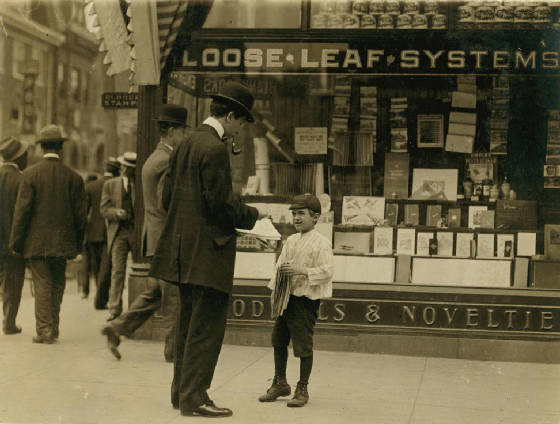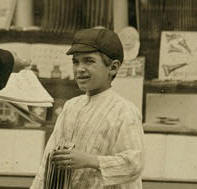
Lewis Hine caption: James Lequlla, newsboy, 12 years of age. Selling newspapers 3 years. Average earnings 50 cents per week. Selling newspapers own choice. Earnings not needed at home. Don’t smoke. Visits saloons. Works 7 hours per day. Investigator, Edward F. Brown. Location: Wilmington, Delaware. May 1910.
“He told me that he was a great pool player. If you look to the left in that picture, you see a row of buildings. I understand that on the second floor of one of those buildings, there was a pool hall that he used to hang out in when he was a boy. He entered a lot of tournaments.” -Tom Logullo, son of James Logullo
This is such a beautiful photo, so rich in detail, and it perfectly captures a typical urban scene of that era. Note the vertical sign for the pool hall just around the corner on the left. Look at all the signs in the window of the store, which sells stationery among what must have been shelves and shelves full of items. No doubt, there would have been something curious in there to catch everyone’s eye. On a busy corner, this store must have been one of the hubs of Wilmington, a great location to be selling newspapers.
Somehow, little James seems to own the spot, perhaps a sign that he has already learned his trade well and will grow up to be a sharp businessman. But he also looks so tiny facing the seemingly tall man, a reminder of his vulnerability. Several decades later, Norman Rockwell would often position children in his paintings in much the same way, allowing us to see the child’s view of the world. Perhaps he learned something from Lewis Hine’s work.
This turned out to be my fastest search for a descendant ever. I saw the photo one morning before breakfast, and after a few clicks on the computer, I found his correct name — Logullo, not Lequlla. On a hunch, I looked up the last name in the Wilmington White Pages and found a Jim Logullo listed at the office of the Boys and Girls Club. I called at 9:00 sharp, and he answered. He was intrigued by the mention of the photo in the Library of Congress. He gave me his email address, and I sent off the picture. A minute later, he said, “Just got it. That’s my grandfather. That’s really something.” He gave me the phone number of one of James’s sons, and within days, I had interviewed him.
Hine is sometimes criticized for underestimating the ages of his subjects, allegedly to inflate the number of children found under the legal age set by the child labor laws of the time. My research of about 160 photos so far has turned up only a handful of such examples, all just one year off. In the case of James Logullo, we have the error in reverse. Social Security death records and Logullo’s son confirm that the boy was born on December 6, 1902, making him only 7 ½ years old when he was photographed. Indeed, he looks that young. According to own testimony, he had already been selling newspapers for three years.
According to census information, he was the son of Italian immigrants, Joseph (originally Giuseppe) and Teresa Logullo, both of whom entered the US about 1900. They were married shortly after. James was the first of at least eight children. His father was a fruit merchant. In 1920, James is listed as a chauffeur, probably a taxi driver. In 1930, he is living in Wilmington with his wife, Anna, and two children, five and six years old. His occupation is still listed as chauffeur, and he rents his house. He passed away in October of 1978, at the age of 75.
Edited interview with Tom Logullo (TL), son of James Logullo. Interview conducted by Joe Manning (JM) on February 26, 2008.
JM: What did you think of the picture of your father?
TL: I had seen the picture in a book a while back, but I don’t think my father ever saw it. It was in a book about old Wilmington, which was published in Delaware. There’s a mistake in it. He was not 12 years old. He was born in 1902, so he was only seven or eight when he was photographed.
JM: Did your father tell you that he was selling newspapers on the streets at that age?
TL: Yes, he told me that, and he told me that he was a great pool player. If you look to the left in that picture, you see a row of buildings. I understand that on the second floor of one of those buildings, there was a pool hall that he used to hang out in when he was a boy. He entered a lot of tournaments.
His parents came from the lower part of Italy. His father’s name was Guiseppe. I think he was in the fruit business. Both of them died very young, so I didn’t know either one of them. I have the wedding picture of his mother and father. My grandmother was very short, and you can tell that she is standing on a stool.
My dad must have liked the name James. He named his first son James. That was from his first marriage. Then he divorced and married my mother, and I was the first son. He named his second son James also. So he had two sons named James Logullo Jr. We had a golf tournament a couple of years ago, and there were four Logullos in it: Tom Logullo, Jim Logullo, Jim Logullo and Jim Logullo. Actually, there are five Jim Logullos in the family.
JM: What was his first wife’s name?
TL: I don’t remember.
JM: When did they marry?
TL: Well, the oldest son James is 82 now, so he was married about a year before that.
JM: When did your father marry your mother?
TL: Well, I was born in 1930, and I was the first child.
JM: What was your mother’s name?
TL: Anna Mae Ludlam.
JM: Did your father graduate from high school?
TL: No. But he was very good at arithmetic. He could figure things out in his head quicker than most people can do with a calculator.
JM: What was the first job your father had as an adult?
TL: He was a cab driver. Then he became the manager of Yellow Cab. That was the biggest cab company in Wilmington then. He was in charge of the mechanics. He would come home with grease all over his hands. At one time, he was a bookie. I think some of his relatives were big in the bootleg business during Prohibition, and he may have fooled around with that. In later years, he started his own cab company. It was called Park Cab. It was in Richardson Park (Delaware). He owned six cabs. He had a bad bookkeeper who ran him into bankruptcy. I was in high school then. When he was much older, he worked as a toll taker on the Delaware Memorial Bridge. He retired when he was 65.
He died of emphysema when he was about 76. He was a very heavy smoker. So was my mother, and the same thing happened to her. Me and my brothers never smoked. When he died, I was retired from the Delaware State Police, and my brother Bob was retired from the Wilmington Police Department. After I retired from the state police, I started making front license plates for fire departments. I make them now for fire departments in five or six states. I’m 77 years old, and I’m a one-man operation. I work in a 10 x 12 shed in my backyard.
JM: What was your father like?
TL: He was a great guy, but he was gone a lot. The main time we saw him was when he’d come home on Fridays and give us our quarter for the week. He worked long hours at the cab company. Sometimes, when someone was sick, he’d have to fill in all night as the dispatcher. They were the main cab company down at the railroad station. But I remember when I was playing football in high school, he never missed a game. We played night games. It would be cold, and he would come with his little pint of whatever he had and stand there and cheer. He was very proud when I was selected All-State.
He belonged to a veteran’s club right across from his cab company, and he’d go over there on amateur night. He loved the Ink Spots and the Mills Brothers and Al Jolson. He’d sing their old songs and people went crazy. He was very good at it. He was in his glory. In later years, after him and my mom got divorced, he lived in a mobile home by himself and did a lot of reminiscing. He helped out his sisters. A couple of them were widows. He spent a lot of time helping other people. He was a very gracious and caring man.
My dad and mom divorced about 1957. My mother married again and moved to Arizona. My father married again, too, but that didn’t last very long because she was hifalutin and dad wasn’t. They got divorced and she moved to Florida. That was about five years before he died. We were very close his last few years. I would stop over three or four times a week to make sure he was okay. By then, the emphysema had taken over pretty much. He would walk up two or three steps to his mobile home, and he’d have to stop at each step to get his breath. One time I went in and the place was smoky, and I said, ‘What are you doing smoking?’ And he said, ‘I’m not inhaling.’

James Logullo: 1902 – 1978
Tom Logullo was unable to find any photos of his father.
*Story published in 2010.